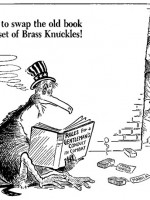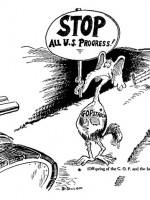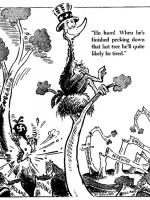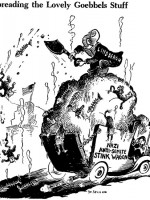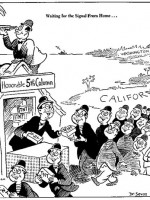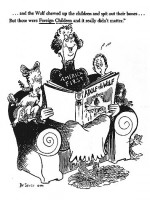Dr. Seuss Goes To War
The Cat and the Hat, The Grinch, Asian stereotypes and propaganda, there is a hidden history to Dr. Seuss’ carrier.
Few people know that Theodor Seuss Geisel, or the beloved Dr. Seuss, not only wrote children’s books about One Fish, Two Fish, Red Fish, Blue Fish, but also illustrated political cartoons on topics ranging from tax exemptions to racism during the years America was involved in the second World War in Europe.
Dr. Seuss Goes to War: The World War II Editorial Cartoons of Theodor Seuss Geisel is a book written by Richard H. Minear, containing Dr. Seuss’s political cartoons created during World War II. Dr. Seuss Goes to War denounced Adolf Hitler and Benito Mussolini and were highly critical of non-interventionists (“isolationists”), most notably Charles Lindbergh, who opposed US entry into the war. There is a strong disconnect between what we usually think of as Dr. Seuss and the content of the cartoons. Gone are the Cats in Hats and instead we have blatant racism and mockery of those involved in the war efforts.
Many of Dr. Seuss’s books also contain serious themes. Yertle the Turtle, for example, is a cautionary tale against dictators. The Lorax contains a strong environmental message. The Sneetches is a plea for racial tolerance. Horton Hears a Who is a parable about the American Occupation of Japan. And The Butter Battle Book parallels the Cold War and nuclear deterrence. Even the Cat in the Hat’s famous red-and-white-striped hat has a political predecessor in the top hat Uncle Sam wears in Dr. Seuss’s wartime cartoons.
it is a surprise that a person who denounces anti-black racism and anti-Semitism so eloquently can be oblivious of his own racist treatment of Japanese and Japanese Americans.
Some of these characters, such as a Sneetch-type creature and a prototype of Yertle the Turtle, made their first appearance not in Dr. Seuss’s children’s books, but in the some 400 political cartoons he drew for PM, a left-wing daily newspaper published in New York from 1940 to 1948. Dr. Seuss worked as an editorial cartoonist for the paper from 1941 to 1943, drawing cartoons that lambasted isolationism, racism, anti-Semitism, Hitler, Mussolini, the Japanese, and the conservative forces in American politics.
The cartoons are all signed “Dr. Seuss,” but even without the signature there would be no mistaking the artist. The drawings are filled with his trademark contraptions and creatures, many of them eerily similar to those in his children’s books. Bizarre animals abound; he often used a dachshund to represent Germany, and cats to represent Japan.
It is Dr. Seuss’s portrayal of the Japanese that is most disturbing. His Japanese characters don’t represent Hirohito or any other well-known World War II figure, in contrast to his obvious pictures of Hitler. Dr. Seuss draws ‘Japan’ with a piggish nose, coke-bottle eyeglasses, slanted eyes, brush mustache, lips parted. It is no surprise that American cartoonists during the Pacific War painted Japan in overtly racist ways, but it is a surprise that a person who denounces anti-black racism and anti-Semitism so eloquently can be oblivious of his own racist treatment of Japanese and Japanese Americans.
One cartoon depicted all Japanese Americans as latent traitors or fifth-columnists, while at the same time other cartoons deplored the racism at home against Jews and blacks that harmed the war effort. His cartoons were strongly supportive of President Franklin D. Roosevelt’s handling of the war, combining the usual exhortations to ration and contribute to the war effort with frequent attacks on Congress, especially the Republican Party, parts of the press (such as the New York Daily News, Chicago Tribune and Washington Times-Herald, and others for criticism of Roosevelt, criticism of aid to the Soviet Union. investigation of suspected Communists, and other offenses that he depicted as leading to disunity and helping the Nazis, intentionally or inadvertently.
To find such in the pages of the leading left newspaper of New York City and to realize that the cartoonist is the same Dr. Seuss we celebrate today for his imagination and tolerance and breadth of vision: this is a sobering experience. I wonder how many parents of Asian decent would read Dr. Seuss to their children if they read these cartoons. But like older Disney movies these strips are from an older time and period where these portrayals were common practice and acceptable. Its fascinating to look back at history and see how far we’ve come as a nation in regards to out portrayal of others and what in now politically correct.
Every person has some sort of past that haunts them in some ways, but Seuss never apologized for his cartoons, he never renounced them as misguided youth, he stood up for them and his views on the tragedy and terror that inspired them. This is so different from modern times when a creator will tend to push aside some older work if it tends to cause controversy or is not fondly remembered.
It’s amazing to look back at the history of one of America’s most prolific cartoonists and find such a black mark on his carrier. Yet, we moved past it. No one mentions these works; no one holds it against The Cat in the Hat. There will not be protest outside the new Lorax movie when it comes out that Seuss was a racist, it is a rare example where we have been able to look past a creator’s flaws and just enjoy the work for what it is.

